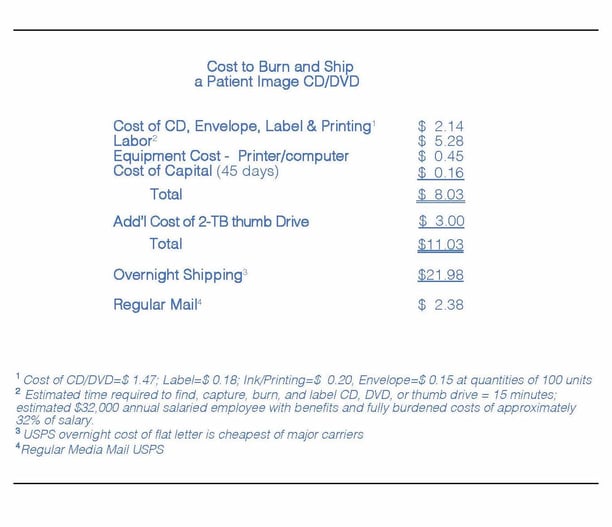How Providers Can Get Comfortable Charging Patients for Copies of Their Medical Images

With limited exceptions, the HIPAA Privacy Rule gives patients and their legal representatives the right to receive copies of their health records, including medical images. Most patients still receive their images on a CD or DVD, incurring substantial costs for the provider. Although the HIPAA Privacy Rule clearly permits providers to charge a reasonable, cost-based fee to help cover the expense, many providers hesitate to do so, fearing their patients will feel like they are being nickel and dimed.
What does it actually cost to produce a CD or DVD for a patient?
While the cost of CD or DVD media has decreased substantially to a dollar or two, the total expense that a provider typically incurs in this process is much higher. Most practices and institutions don’t have a clear idea what it costs their organizations to produce these discs, not to mention to deliver them. Mailing and overnight shipping costs can add up quickly.
Industry wide, we have found that the cost to generate a CD or DVD for a patient, including all direct and indirect costs, is between $10 and $25. With postage or overnight mailing, this can increase the cost by $3 to $50, depending upon the carrier. When you’re producing and delivering these regularly, these costs carry a large impact. From a women’s health facility generating 10 CDs a day to a hospital generating 50 or more each day, the expense incurred by this process can amount to tens or even hundreds of thousands of dollars each year. Without patient fees helping to cover the costs, the provider’s bottom line takes the hit.

Another area impacted by this process, perhaps even more so, is the institution’s staff. Providing patients with a copy of their images on a CD takes valuable time and labor away from the institution’s daily operations, which can negatively affect both staff and patients. Waiting for the images to be written to the CD, along with applying the appropriate labeling, extends a patient’s check out, which may reduce the number of patients a practice can accommodate. It could also lead to a disgruntled patient who becomes annoyed by the wait time. Overall, this distraction may contribute to reducing the level of customer service that the practice aims to deliver.
Is there a better way to serve your patients?
Despite being the predominant delivery mechanism for medical images, CDs are not the optimal method. Today, most computers don’t even have a CD drive. Instead of burning CDs or DVDs of a patient’s image, providers should instead consider providing online access to images for the patient and his or her attending physician. Below is a list of benefits this alternative provides:
1) Not burning CDs can save money and time. The cost of providing electronic access is almost always significantly cheaper than burning a CD. In addition to requiring no shipping costs, and providing immediate patient access, your employees’ time is no longer consumed by the process of burning, labeling and mailing CDs.
2) Faster access to images. Electronic access obviates the delay of having to physically deliver a CD. This is generally more convenient for the patient and their referring physician, and, in situations of a critical illness, can make a significant difference in health outcomes.
3) Avoid damaged, incorrect or lost discs. Across the healthcare industry, we have witnessed a substantial percentage of discs that are not useable. The issues range from damaged media, to incorrect labels, wrong patient information, or simply lost discs. On top of delaying progress in caring for the patient’s condition, these issues result in duplicated costs for the provider as they must remake and resend a copy of the disc.
4) Better image viewing. With an electronic system, the physician (or patient) viewing the image is not relegated to the often limited-function viewing software included on the CD. Electronic access with a fully featured, FDA-approved viewer enables an accurate read.
5) Patients avoid unnecessary radiation. When patients forget or don’t have their media when visiting with their specialist, they often get reimaged. This is expensive and subjects the patient to duplicate radiation from a new scan. Providing images electronically would prevent this unnecessary exposure and cost.
6) Physicians avoid missed appointments. Most physicians carefully schedule their day, trying to efficiently handle patient appointments. When a patient forgets or misplaces a CD, or if the CD doesn’t work, this may prolong the visit or delay the appointment or procedure. This can have enormous scheduling and financial implications for the provider.
7) Effective long-term storage. We all know patients who have shoe boxes full of CDs from their various scans. Once an image is made available electronically, the patient and/or his or her physician can have continual access for extended durations, obviating the need to store and keep track of individual CDs.
What is a reasonable cost-based fee for electronic access?
As we’ve established, providing patients with electronic access is much cheaper than burning a CD, not to mention it also includes many additional benefits. The very process of providing a CD requires that the image is in an electronic format anyway so why not get rid of the extra steps and expense? While you’ll save time and money with electronic access, there will still be some expense in providing this service to patients, though it’s minimal in comparison to the labor and material costs of providing CDs.
According to HIPAA’s Privacy Rule, providers can help cover the costs of sharing images, regardless of the way they are delivered, in the following ways: charge a patient for the actual cost of providing the image electronically to the patient, take the average of those costs across its practice, or use a safe harbor fee of $6.50 per study.
Your particular state may regulate these fees itself. However, if the patient fees prescribed by your state are higher than those set forth by HIPAA, HIPAA’s restrictions override.
Can I outsource the function?
You may also consider outsourcing the entire process of storing and sharing images electronically, freeing up your staff to focus on other important tasks. Purview provides a complete service where we handle the accessing, sharing and storing of patient images, enabling them to easily share their scans with their referring physicians; we also support patients in their use of the system so your staff doesn’t have to worry about any technical issue or user error the patient might be experiencing. By outsourcing this process, your staff is free of the headache, cost and related distractions of burning CDs for patients. In high volume practices that integrate a cost-based patient fee, you might even transform this function into a profit center.
Summary
With the host of benefits outlined above, both for the provider and the patient, it’s time for providers to reconsider charging their patients for the cost of providing copies of medical images. Institutions who choose to modernize their businesses by providing electronic patient access to images, rather than a burned CD, can improve the overall patient experience. Their staff will be more efficient, especially if this service is outsourced, and will experience fewer interruptions due to forgotten, lost or damaged discs. And patients can receive more efficient care and a smoother imaging process, from scan to diagnosis to second opinion to treatment, in return for what will now be only a nominal fee.

